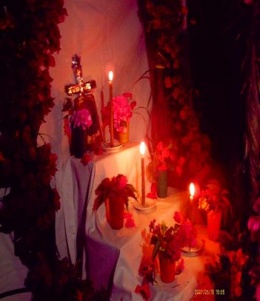4.3.1 Cross Altars in 17th Century Cuban Theater

The festival known as the Altar of the Cross or the Cross of May is of Spanish religious origin. Although it is celebrated throughout the Christian communities, it was in Spain that secular elements were added, making it a popular festival. It was established in the communities colonized by the Spanish, whose inspiration was to praise the invention of the Cross.
Part of the blending of two festive traditions: the pagan ceremony of the arrival of spring in large areas and the establishment of the Day of the Holy Cross by the Catholic Church in Rome.
This festival arrived in the Cuban archipelago brought by the Spanish conquistadors. It reached a peak in Cuba in the 17th century, which led to strong popular support. It was most commonly celebrated in the eastern region, especially in the town of Santiago de Cuba, where it was held throughout the fifth month of the year.
The May Cross was a family celebration. It involved erecting altars in homes where the Holy Cross would predominate. This was surrounded by offerings consisting of fruits and flowers in homage to spring, commemorating pagan festivals collected and transformed in Spain.
The altar was built with three steps on May 3rd, and the number of steps increased until the culmination of the festivities. Its essence consists of songs, which were transformed in the hands of the poor. After the various choruses were sung, various prayers, the song of forgiveness, and the Hail Mary were recited. The Cuban Cross of May had a distinctive feature: the use of an African drum.
The forms of celebration varied from one region to another in the country; an example of this is the use of Punto Cubano in the central and western regions, where verses were improvised to the cross and saints.
The first reference to the celebration of the Altares de Cruz festival that we find in Cuba dates back to 1684, recorded in the VII Constitution of the Diocesan Synod, where it was recognized along with other events related to the Catholic-Hispanic tradition that later appropriated profane elements.
This holiday is still celebrated today in rural areas of the southeastern part of the country. Although its origins are Catholic, over the years it has become a major popular celebration in Cuba.
The May Cross Altars built in rural areas exhibit different characteristics than those in urban areas. In rural areas, peasants, regardless of skin color, appropriated this festival, hence its deep roots. Cuban peasants made fundamental changes to the altar decoration and the songs.








